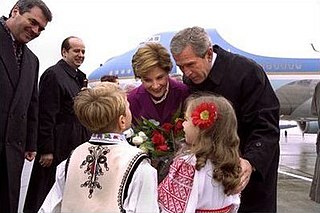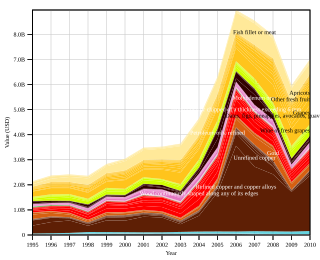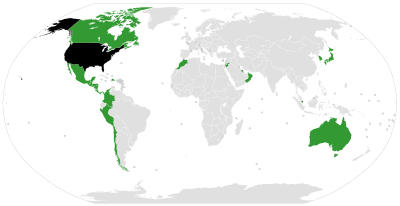
The Free Trade Area of the Americas (FTAA) was a proposed agreement to eliminate or reduce the trade barriers among all countries in the Americas, excluding Cuba. Negotiations to establish the FTAA ended in failure, however, with all parties unable to reach an agreement by the 2005 deadline they had set for themselves.

The Dominican Republic–Central America–United States Free Trade Agreement is a free trade agreement. Originally, the agreement encompassed the United States and the Central American countries of Costa Rica, El Salvador, Guatemala, Honduras, and Nicaragua, and was called CAFTA. In 2004, the Dominican Republic joined the negotiations, and the agreement was renamed CAFTA-DR.

The main event by far shaping the foreign policy of the United States during the presidency of George W. Bush (2001–2009) was the 9/11 terrorist attacks against the United States on September 11, 2001, and the subsequent war on terror. There was massive domestic and international support for destroying the attackers. With UN approval, US and NATO forces quickly invaded the attackers' base in Afghanistan and drove them out and the Taliban government that harbored them. It was the start of a 20-year quagmire that finally ended in failure with the withdrawal of United States troops from Afghanistan.

The Western Bloc is an informal, collective term for countries that were officially allied with the United States during the Cold War of 1947–1991. While the NATO member states, in Western Europe and Northern America, were pivotal to the bloc, it included many other countries, in the broader Asia-Pacific region, the Middle East, Latin America, and Africa with histories of anti-Soviet, anti-communist and, in some cases anti-socialist, ideologies and policies. As such, the bloc was opposed to the political systems and foreign policies of communist countries, which were centered on the Soviet Union, other members of the Warsaw Pact, and usually the People's Republic of China. The name "Western Bloc" emerged in response to and as the antithesis of its Communist counterpart, the Eastern Bloc. Throughout the Cold War, the governments and the Western media were more inclined to refer to themselves as the "Free World" or the "First World", whereas the Eastern bloc was often referred to as the "Communist World" or less commonly the "Second World".
The US-Morocco Free Trade Agreement is a bilateral trade agreement between the United States and Morocco. The agreement was signed on June 15, 2004, followed by U.S. President George W. Bush's signing of the USMFTA Implementation Act on August 17, 2004. The United States House of Representatives ratified the pact on July 22, 2004 by a 323–99 vote. The United States Senate passed the bill by unanimous consent on July 21, 2004. The Morocco FTA came into effect on January 1, 2006.

The U.S.-Oman Free Trade Agreement is a trade pact between Oman and the United States. On November 15, 2004, the George W. Bush administration notified the U.S. Congress of its intent to sign a trade agreement with the Middle Eastern Sultanate of Oman. On January 19, 2006 the two countries signed the U.S.-Oman Free Trade Agreement (OFTA), which is part of the Bush administration's strategy to create a US - Middle East Free Trade Area (MEFTA) by 2013.
The United States–Bahrain Free Trade Agreement (USBFTA) is a free trade agreement (FTA) between the United States and Bahrain, signed on September 14, 2004. It was ratified by the United States House of Representatives on December 7, 2005, by 327–95, with 10 not voting.

The United States–Singapore Free Trade Agreement was signed 6 May 2003 and ratified by the US House of Representatives on 24 July 2003 by a vote of 272-155. The US Senate ratified the bill on 31 July 2003 by a vote of 66-32. President George W. Bush signed into law the United States-Singapore Free Trade Agreement Implementation Act on 3 September 2003. The trade pact was implemented by both countries on 1 January 2004.
The United States–Israel States Free Trade Agreement (FTA) is a trade pact between the State of Israel and the United States of America established in 1985 to lower trade barriers in some goods. The agreement reduces rates of duty, and in some case eliminates all duties, on merchandise exported from Israel to the United States. The agreement also covers merchandise exported from the Gaza Strip and the West Bank.

New Zealand is party to several free trade agreements (FTAs) worldwide.
Colombia is a relatively open, free market economy that is party to many free trade agreements (FTAs) worldwide. It has signed free trade agreements with many of its biggest trading partners including the United States and the European Union, and is a founding member of the Pacific Alliance regional trade bloc.

The European Union has concluded free trade agreements (FTAs) and other agreements with a trade component with many countries worldwide and is negotiating with many others. The European Union negotiates free trade deals on behalf of all of its member states, as the member states have granted the EU has an "exclusive competence" to conclude trade agreements. Even so, member states' governments control every step of the process :

The United States-Chile Free Trade Agreement is a free trade agreement (FTA) between the United States and Chile signed on June 6, 2003. The pact came into force on January 1, 2004. On that date, tariffs on 90% of U.S. exports to Chile and 95% of Chilean exports to the United States were eliminated. The agreement also established that Chile and the U.S. will establish duty-free trade in all products within a maximum of 12 years (2016). In 2009, bilateral trade between the United States and Chile reached US$15.4 billion, a 141% increase over bilateral trade levels before the U.S.-Chile FTA took effect. In particular, U.S. exports to Chile in 2009 showed a 248% increase over pre-FTA levels.

The free trade agreements of Canada represents Canada's cooperation in multinational trade pacts and plays a large role in the Canadian economy. Canada is regularly described as a trading nation, considering its total trade is worth more than two-thirds of its GDP. Of that total trade, roughly 75% is done with countries that are part of free trade agreements with Canada—primarily the United States through the Canada–United States–Mexico Agreement (CUSMA), and its predecessor the North American Free Trade Agreement (NAFTA). By the end of 2014, Canadas bilateral trade hit Can$1 trillion for the first time. Canada is a signatory to 15 free trade agreements with 51 different countries.

The Pacific Alliance is a Latin American trade bloc, formed by Chile, Colombia, Mexico and Peru, which all border the Pacific Ocean. The alliance was formed with the express purpose of improving regional integration and moving toward complete freedom in the movement of goods, services, capital and people between the four member states. Together, these four countries have a combined population of more than 230 million people and make up roughly 35 percent of Latin American GDP.
The negotiations for the Trans-Pacific Partnership Agreement were held between 12 countries between 2008 and 2015. The negotiations were aimed at obtaining an agreement between the Trans-Pacific Strategic Economic Partnership Agreement parties Brunei, Chile, Singapore and New Zealand, as well as the Australia and the United States.

Following its withdrawal from the European Union on 31 January 2020, the United Kingdom began negotiations on several free trade agreements to remove or reduce tariff and non-tariff barriers to trade, both to establish new agreements and to replace previous EU trade agreements. Withdrawal ended 47 years of membership during which all its trading agreements were negotiated by the European Commission on behalf of the bloc. The UK did not actually withdraw from the European Single Market and the European Union Customs Union until 31 December 2020.

The free trade agreements of Israel represent Israel's cooperation in multinational trade pacts and participation in the global economy. Israel's first free trade agreement was signed in 1985 with the United States of America. Since then, Israel has signed 14 free trade agreements with 46 countries and economic blocks such as the European Union, the European Free Trade Association and Mercosur.














